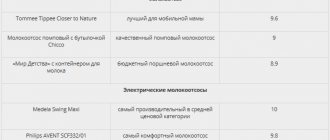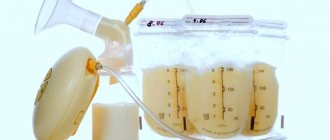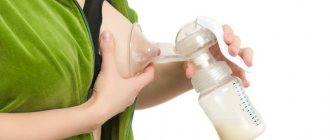How to express breast milk correctly and effectively?
- this should be done in a room alone so that no one disturbs you.
The room should be warm. Think about your baby. This way the milk will come out faster; - if the breasts are firm to the touch, it is better to massage yourself before pumping;
- You need to express every 3 hours during the day and try at least once at night;
- It happens that milk does not flow well from one breast, so switch to the second breast, and then to the first. And you will see that the milk has become better;
- For cracks, you should use vegetable oil or lubricate the nipples with Dexpanthenol cream.
What to consider before purchasing
Before choosing a breast pump, consider how often you will use it. If you need to express from time to time, it is better to purchase a manual device. For constant use, of course, it’s worth forking out for an electric one. And if finances allow, then take both - for home use and travel. In addition, there is always the opportunity to buy a used breast pump, as well as rent one.
When choosing a mechanical model, consider:
- Piston and syringe devices are much more effective than pump devices (breast pumps with a bulb) and do not injure the breast. In addition, pump models can provoke lactostasis.
- A silicone, or ideally anatomical, pad is much better than a plastic one. Firstly, it is more hygienic. Secondly, it does not cause discomfort during the pumping process. Thirdly, it prevents milk from spilling.
- It is necessary to choose a breast pump with all the parts and additional accessories: containers, nipples, nozzles. This saves time.
When purchasing an electronic breast pump, remember:
- It’s better to immediately purchase a set of silicone petal-shaped attachments than to look for the right size later.
- The best breast pump is one that runs on both mains power and batteries. This makes it more functional. If you have your eye on this model, please note that batteries are sold separately. Better yet, immediately select a device with a battery for which you need to purchase a charger.
- In order not to purchase two devices at once - mechanical and electronic - give preference to a universal model with a removable motor. Use it at home, plug it in, and take it to work or on a trip as a manual breast pump.
- You definitely need to pay attention to the material from which the device is made. Sometimes the price of a model can be reduced just because it is made of cheap plastic. Firstly, such material is short-lived. Secondly, it can harm the health of the mother and child.
- The two-phase pumping system delicately prepares the breasts for the procedure, performing massage in the first stage. In the second stage, the chest is completely emptied. It’s even better if the device has more than two modes.
When choosing a breast pump, whether it's a manual or electric model, look to see if it's easy to clean. If the device is difficult to disassemble, then complete sterilization is impossible. Also pay attention to which parts can be sterilized and which cannot. Take care of purchasing a breast pump in advance so that you can easily compare different models and choose the right one.
We recommend reading: Which mattress to choose for a newborn
Types of breast pumps:
- electronic;
- manual : piston, pump, pear, syringe.
Electronic breast pump
There are many electronic breast pumps available in the market today.
The most common is the Avent breast pump. In terms of price, this product is quite expensive - about 3,000 rubles. The kit may also include special containers for storing milk.
Manual breast pumps
These are the best places to start.
- Piston breast pump. Easy to use. There is a special piston that allows milk to be expressed. The disadvantage is that mom’s hand gets tired quickly.
- Pump breast pump. It has accessories - pump, nozzle, bottle. Its big drawback is the lack of sterilization capabilities.
- Pear. A special rubber bulb and nozzle make it easy to use. Can be sterilized.
- Syringe or vacuum breast pump. In structure, these are two cylinders located one inside the other. One cylinder is placed on the breast, and the second one makes forward movements, due to which a vacuum is created and milk begins to be released from the breast.
Which breast pump to choose
There are two main types:
• Manual
;
• Electric
.
The principle of their operation is identical - milk is expressed due to pressure changes and creating a vacuum: using a rubber pump/bulb if you are using a manual device, or using a piston/electric pump if your breast pump has an electric drive unit.
The devices are different:
• Pump-action
. The breast attachment goes into a pump, the pumping process resembles measuring blood pressure. The bottle is not attached to it; the milk will need to be poured into a prepared container yourself.
• Pump-action improved
. It is also pear-shaped and equipped with a nipple shield. Unlike its predecessor, it is possible to attach a bottle.
• Piston
. It is a plastic breast attachment covered with a silicone insert. Milk is expressed using a lever. The bottle is included.
Pros and cons of manual breast pumps.
• A pump breast pump is the most economical option. This is undoubtedly its advantage. But it copes with the pumping function very poorly. The process is quite long, and frequent use can lead to the formation of cracks in the nipples.
• Piston breast pump is the most popular. It imitates the baby's sucking as accurately as possible, thanks to which the lactation process is improved. With its help, pumping takes less time, and it does its job better than a pump pump. When choosing it, there is no question of how to use the breast pump, since it is very easy to use. Another advantage is the affordable price, unlike an electric one. The disadvantages include: the fragility of the structure, the design of the mechanism. Pumping for a long time may cause your hand to become tired.
Pros and cons of electric breast pumps.
The electric assistant is an innovative find for a nursing mother. Due to the absence of physical stress on the woman’s hand, the process of expressing milk becomes very easy. There are models that make it possible to obtain milk from two breasts simultaneously. The main advantage is the safety of constant use - the pad and delicate operating mode of the electric breast pump do not damage the nipple. The device has several modes. Some models have a memory function, which allows you to save the pumping mode that suits your mother. Just like a manual breast pump, an electric one can be completely disassembled. All parts are easily removed and can be sterilized separately. The disadvantages are high cost and noisy operation.
How to properly express breast milk with a manual breast pump?
- It is best to start expressing breast milk using a manual breast pump. This way you will feel the strength and pressure that is comfortable for you.
- Before use, the manual breast pump should be boiled for a couple of minutes.
- Wash your hands with soap. It is not necessary to wash your breasts with soap, as soap dries the skin and increases the likelihood of a cracked nipple.
- The nipple should be placed in the middle of the breast pump nozzle.
Support your chest with your right hand. The nipple should not be pinched and there should be no sharp pain. - If your breast pump has a plunger, press it gently.
At first, droplets will appear, and gradually the milk will begin to flow out in streams. Do not put pressure on your chest; bruising may occur. Using gentle movements, you can massage the mammary gland to facilitate the release of milk. It is also useful to take a warm shower before pumping. A bulb breast pump works on the same principle, but instead of a piston there is a rubber bulb. - Expressing with a breast pump should be carried out until you feel relief in the chest.
You shouldn’t do a complete emptying, and you won’t be able to, anyway, some milk will remain in the breast. In general, with mechanical pumping, one procedure takes about 10 minutes. During one pumping procedure, two breasts should be emptied at once in turn. - After this manipulation, the breast pump must be disassembled and washed with soap and running water. Then dry on a towel without wiping. No need to boil.
Breast milk can be stored in the freezer in special containers for up to six months.
Characteristics of the Avent breast pump
The Avent breast pump consists of:
- silicone massage attachment for the chest;
- 125 ml bottles with cap;
- nipples made of silicone, repeating the shape of the mother's breast;
The package also includes bra pads (4 pieces). In specialized children's stores you can purchase additional parts that are not included in the kit - containers and bags for storing and freezing breast milk.
The device body, depending on the model, is equipped with a manual or electric control unit with a power regulator. Avent breast pumps do not contain hazardous compounds. Therefore, we can assert the sterility and quality of the expressed maternal product, but subject to proper preparation of the product.
Using a breast pump with an electric device
How to use a breast pump with this mechanism? First, read the instructions.
As already mentioned, the most convenient is a modern breast pump.
Pros:
- does not contribute to mom’s fatigue, is gentle on the nipple;
- memory. Remembers pressure and pumping mode;
- ease of use, sterilization;
- There are modes in which fast pumping occurs first, then slow and deeper.
This breast pump operates either from a wall outlet or from a battery.
Don't worry if you don't succeed right away. You need to get used to this.
Anastasia, 28 years old: “After the birth of my daughter, I had to resort to pumping.
I used a manual breast pump. At first it was painful and unpleasant, but after a few days I got used to it. Nothing wrong with that".
Breast pump rating
Sometimes it is difficult for young mothers to understand the large amount of information about assistive devices. We have compiled a rating of the most popular models for you.
Manual
:
Philips Avent. This manufacturer has established itself as a leader specializing in children's products: nipples, bottles, sterilizers. A unique nozzle with petals imitates the process of a baby sucking at the breast. Thanks to its small size and light weight, the breast pump is easy to store and take with you on the go, which makes pumping on the go more discreet.
Medela Harmony. All Medela breastfeeding accessories are made in Switzerland and are characterized by true Swiss quality.
Pigeon. The Pigeon two-phase breast pump allows you to express milk in a comfortable mode, as close as possible to breastfeeding your baby.
Electrical
:
Medela. Compact electronic breast pump for expressing one or two breasts.
Philips Avent Ultra Comfort. Breast pump with 1 stimulation mode and 3 expression modes. The kit includes a soft massage attachment that stimulates milk flow.
Pigeon Pro. Two-phase breast pump with built-in timer: automatically switches from stimulation mode to expression mode after 2 minutes of operation.
Why pump at all?
During normal lactation, the baby should consume breast milk as much as he needs. And you don’t need to express yourself. But if you feel that your breasts are tight or sore, then there is a slight stagnation of milk. Then you need to express in small portions until relief occurs.
Also, the pumping procedure should be carried out in case of separation from the baby, illness of the mother, or taking medications that are contraindicated during lactation.
Your pediatrician or lactation specialist can also help you choose the right breast pump. Of course, a manual breast pump is not so easy to use, but it is better to start expressing with it.
Why do you need a breast pump?
Pumping is necessary if:
- Mommy got sick. If certain diseases occur, pediatricians strongly recommend temporarily stopping breastfeeding. Expressing breast secretions during treatment will allow a woman to maintain lactation and prevent congestion.
- A lactation crisis occurred, which is characterized by a decrease in milk production. You can increase its volume by frequently putting your baby to the breast or pumping.
- The baby does not eat the entire volume of food secreted by the mother’s mammary glands. To prevent or eliminate the development of lactostasis, it is necessary to regularly empty the breasts.
Expressing breast milk can be done with any type of device (manual or electric).
How to use a breast pump - video instructions
- Sterilize your breast pump.
- Assemble the device.
- Wash your hands thoroughly and clean your breasts.
- Sit on a comfortable chair and completely relax.
- Get ready to pump , imagining your own child near your breast. This will help “start” the process of milk secretion.
- Position the nipple in the center of the flange so as to prevent it from rubbing against the plastic of the device.
- When using a pump model, you should begin rhythmically pressing the pear .
- Using a piston model, lower the lever several times, adjusting the intensity of the mode .
- Using an electric breast pump also begins with selecting the required mode of exposure .
- You should not expect the milk to immediately splash and flow like a river. Be patient and take your time. At first you will only see drops of expressed milk, but after a minute the pumping process will go much faster.
The optimal pressure force is considered to be the one at which the milk flows in a uniform stream or splashes, pulsating , but without pain or other unpleasant sensations.- As soon as the milk stops flowing, the pumping process can be considered complete . As a rule, pumping takes 10-20 minutes with mechanical breast pumps, about 5 minutes with electric models.
- After using the breast pump, rinse and dry all parts .
When storing breast milk in the refrigerator (freezer), do not forget to tightly close the container and write down the pumping time .
How to assemble a breast pump
Regardless of which breast pump you purchased - electric or mechanical, before you start expressing breast milk, you must carefully read the instructions for use. This will help avoid a number of mistakes that can cause damage to the device or complications from the mammary glands.
Before expressing, you need to prepare in advance a container in which breast milk will be stored. This could be a sterilized bottle or other utensils.
After this, the breast pump parts are prepared. For this purpose, they are also sterilized by boiling or steaming in a water bath. Then the breast pump should be assembled according to the instructions.
Is a breast pump really necessary? How does a breast pump work?
Many argue about the benefits and harms of pumping. Some time ago, categorical statements were made about the need to pump for successful feeding and increased lactation. Today there are more opponents of this procedure. In their opinion, it is impossible to express milk, and those who advise this procedure should be persecuted. There is a third side: you can express milk, but only when there is a need. What is the benefit of a breast pump ?
- Stimulation of lactation. As you know, when the baby’s breasts are completely emptied, milk is produced in the same amount (or a little more). If the baby eats less than the amount of milk available in the breast, the amount is reduced. Pumping helps you maintain (and increase) your milk supply. If there is enough milk, then most likely there is no need for additional stimulation of lactation, but if there is not enough, then using a breast pump is a quick and easy way to increase the “portions”.
- The ability to feed the baby with breast milk in the absence of the mother. Not every young mother can be inseparable from her baby. Some people need to study, others need to work - the situations are different. But this does not mean that mothers should give up breastfeeding altogether. Expressing milk easily solves this problem.
- Prevention of lactostasis.
Most often, such prophylaxis is needed for first-time mothers to avoid milk stagnation. Feeling hard lumps and pain in the chest after feeding is a signal that action needs to be taken. With the help of a breast pump, the milk ducts are “developed”, and the risk of lactostasis is significantly reduced. - Maintaining lactation. In cases such as a young mother being forced to take antibiotics, hospitalization and other health problems, it is impossible to feed the baby with breast milk. But a short break from breastfeeding is better than completely transferring the baby to artificial nutrition. To prevent lactation from disappearing during treatment, you should regularly express milk. Again, this is easiest to do with a breast pump.
Sterilizing a breast pump
We have already mentioned how important it is to sterilize the device and everything that can come into contact with breast milk. Now we should talk more specifically about the sterilization procedure itself. It is important to consider several rules:
- first of all, the device must be boiled immediately after purchase, that is, before first use;
- Wash and sterilize the device immediately after use. This will allow you to quickly prepare for the next pumping procedure and not forget about sterilization;
- For the procedure, they use a special sterilizing device, a double boiler, or the old method - a saucepan with boiling water. Duration is 5 - 10 minutes;
- Having sterilized the device and its parts, you need to dry everything and put it in a box for storage.
Be sure to refer to the instructions that came with your breast pump before sterilizing it. It is in the annotation that it is indicated which parts and components can be sterilized or boiled, and which are strictly prohibited.
Part 1: What to choose: manual or electric?
There are many more articles on breastfeeding from breastfeeding specialists on our portal. More information on the page “Encyclopedia of breastfeeding from the portal “Brudnichok””.
Which breast pump is better: manual or electric?
On store shelves, as well as on the Internet, you can find many devices with different functions and, of course, different prices. Without exception, all models are divided into manual or electric. The first assume that a nursing mother expresses milk by pressing a special handle or bulb on the device, the second do not require any effort on the part of the woman and operate on mains power or batteries. Let's briefly look at what the main modifications of these devices are.
Manual breast pumps
There are several types of hand-held devices - piston, pump, syringe and bulb.
Piston models are considered the most efficient in this segment. They are equipped with a special handle, rhythmic pressing of which creates a vacuum inside the cup adjacent to the nipple, due to which the milk is separated. Such models have a relatively low price and cope with their task quite effectively. However, if you regularly express your breasts with such a manual breast pump, you can develop pain in the muscles of your arms and fingers, as this requires physical effort. However, this design is the most successful and convenient to use among all manual models.
A manual bulb pump works on approximately the same principle as a piston pump, but instead of a handle you need to squeeze a special bulb.
Pump-type manual models are the simplest and most inexpensive, but are considered ineffective and, with frequent use, threaten to injure the chest and cause cracks. The design of these breast pumps is simple - a funnel and a special pump. Available with or without a bottle.
Syringe models consist of two cylinders - one inside the other. Using a manual breast pump of this modification is just as simple: the inner cylinder is applied to the nipple, and the outer one, thanks to the back and forth movement, pumps up a vacuum, which causes a rush of milk.
Electric breast pumps
Electric models are equipped with a special motor that creates the necessary vacuum in the breast pump without your help. Such models are produced in various configurations - with one bottle or with two for faster pumping, as well as with the ability to select a pumping mode (from 1 to 4).
Also in this category you can find models marked “electronic”. These breast pumps are not so compact, but are equipped with various sensors and a special display. The price of such models is, of course, higher, but is justified by the convenience and higher efficiency of the device. Some manufacturers, such as Medela, offer to rent an electronic breast pump. These models suggest the possibility of replacing all parts that come into contact with milk, which ensures hygiene and safety of the pumping process.
Electronic breast pumps are usually larger than their simpler counterparts
To choose a breast pump, it's important to decide how often you plan to use it: expressing breast milk may be something that happens to you once or twice, or something that will become part of your daily life. As a rule, this will only be known for sure when the baby is born. But this largely depends on whether you need a manual or an electric device.
Let's try to guess what your pumping regimen will be. Here is a list of the most common reasons that require single or more frequent pumping.
Rare or sporadic pumping
The most popular reasons for rare pumping are usually:
- cracks in the nipples, when feeding the baby is too painful, but it is important to establish lactation
- decongestion if the baby refuses to take an overfilled breast
- as well as the need to leave for a short time
In these cases, there is no point in overpaying for expensive electric models; you can choose a simple manual breast pump with a handle or bulb. Moreover, if you want to save money, you can do without the device altogether and express breast milk by hand .
The most popular models of manual breast pumps in this category: Philips AVENT Natural SCF330/20 - from 2000 rubles. Medela Harmony - from 1330 rub. Chicco Wellbeing - from 1990 rub.
Frequent but irregular pumping
If you plan to leave your baby with someone else from time to time or keep a small supply of milk for future use, you may want to consider purchasing an electric breast pump model, powered by mains and/or batteries. This will help significantly save time and also protect you from overworked fingers. The most important thing here is to choose the right breast shield size for effective pumping.
Despite the obvious advantages of electric breast pumps, their prices cannot be called so affordable. In an attempt to save money, many consider purchasing used appliances. This should not be done, since a breast pump is considered a device for individual use. If you do decide to buy a used breast pump, be sure to properly sterilize all its parts , consider replacing those parts that come into contact with breast milk during the collection process!
For irregular pumping, you can choose electric models from this list: Medela Mini - from 4,400 rubles. Philips AVENT Natural SCF332/01 from 5990 rub. Medela Swing Single - from 6700 rub. NUK Luna - from RUB 5,300.
Regular, daily pumping
There are situations when a woman has to fit the use of a breast pump into her routine. For example, if there is a need to go to work early, but you continue to feed your baby milk, or if the child for some reason has refused to breastfeed, but continues to receive breast milk from a bottle.
In this case, we recommend that you pay attention to models that provide the ability to simultaneously express both mammary glands, which will greatly reduce the time spent on this process.
Here are a few options from which you can choose if you plan to express milk daily: Medela Swing Maxi Double - from RUB 8,400. Ardo Calypso Double Plus - from 10,080 rubles. Medela Freestyle Double - from RUB 15,990.
[Back to the beginning of the article]
Possible problems with your breast pump
In some situations, the device does not work as stated in the instructions and as the woman expects: milk is not expressed, pain is felt during the procedure, milk secretion flows out from under the nozzle. The most common problems and ways to solve them are described below.
- there is no vacuum. In this case, you should check the integrity of the rubber valve. If there is a tear, you need to replace the membrane with a new part. Another source of the problem is a clogged motor. If the design allows, the motor must be cleaned of dirt;
- milk doesn't go into the bottle. Check how tightly you have assembled the device and whether there is a vacuum. Be sure to check whether the pad is adjacent to the chest and whether the valve is damaged. Also, mom should relax as much as possible;
- pain when expressing. Check the pumping intensity; perhaps you have set the mode too high or are pressing the pump too hard. Avoid high-power modes when using electrical appliances;
- milk secretion makes its way from under the funnel. In this case, you need to remove the nozzle, wipe the chest dry, and put the funnel back on. You should also make sure that this part fits tightly to the skin. If there is a crack or tear on the lining, you need to replace the damaged part.
Even if the breast pump is not working, there is no need to be nervous, as this will only worsen the entire pumping process. Carefully inspect the device, check the correct assembly and start over. If you constantly feel pain when pumping, refuse the procedure and consult a doctor.
Sources
- https://jliza.ru/molokootsos.html
- https://vyboroved.ru/vybor/1248-kak-vybrat-molokootsos.html
- https://kroha.info/pokupki/breast-pumps/kak-vybrat-molokootsos
- https://ProGrudnoe.ru/gadzhety/kak-polzovatsya-molokootsosom.html
- https://razvitie-krohi.ru/kormlenie-grudyu/10-luchshih-molokootsosov.html
- https://mama66.ru/gv/kak-vybrat-molokootsos
- https://heaclub.ru/kak-polzovatsya-ruchnym-molokootsosom-vazhnye-pravila-i-poshagovoe-opisanie-kak-pravilno-scezhivat-grudnoe-moloko-molokootsosom
- https://mammolog.guru/beremennost-i-laktaciya/grudnoe-vskarmlivanie/kak-polzovatsya-molokootsosom.html
- https://sberemennost.ru/after/kak-polzovatsya-molokootsosom
[collapse]
How often can you express milk?
A woman should learn to express milk correctly in the first days after giving birth. For sufficient milk production, you need to express it on time, at least every three hours, including night pumping. To increase your milk supply if your milk supply has decreased, you should pump more frequently for several days, every two hours during the day and every four hours at night. To alleviate the condition with the development of lactostasis in order to relieve stagnation of milk in the breast or with mastitis, it is necessary to pump as often and for as long as the corresponding condition requires. To prevent the formation of cracks or treat them, it is recommended to express colostrum or “hind” milk at the end of feeding the baby and lubricate the nipple with it.
Which is better to choose a mechanical or electric breast pump?
An electric unit outperforms a manual breast pump in many ways. It is more productive, faster and more convenient. Your income level determines which breast pump is best for you. Electrical devices are several times more expensive than mechanical ones. It makes no sense to purchase such units and overpay a lot of money for them if the young mother pumps quite rarely.
To summarize, it is worth noting that there are quite a large number of breast pumps. When choosing a device, a woman should understand how often she will use this device. Experienced mothers advise taking a cheap pump breast pump to the maternity hospital. After the first days after childbirth, the amount of milk produced will make it clear whether to purchase a pumping device or not.











